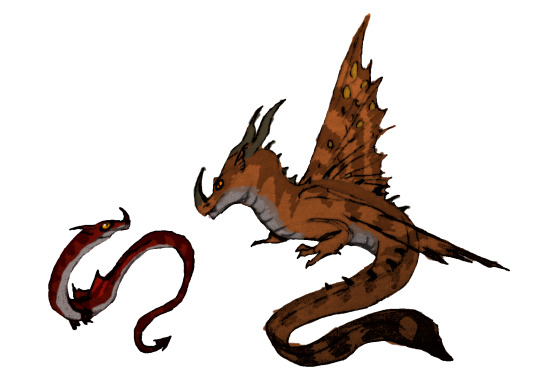#meatlug is also a gremlin
Photo

did it again...but with DRAGONS :DDDDD
#loving the new dynamics#toothless is just hiccup#stormfly is a gremlin#meatlug is also a gremlin#hookfang is an intellectual#Barf and belch are chaotic neutral and done with everything#i think windsheer is just sad#i thought about doing this for like 2 days#rtte#incorrect rtte quotes#httyd dragons
17 notes
·
View notes
Text
Dragons of the Wilderwest
So in Dracones Mundi all dragons start out as serpentine creatures - this would also be true if the Wilderwest existed in this world. The dragons would appear as brown or black serpents with a few mottled patterns or spots. After about a year they will start to develop more defining characteristics; interesting colours, small wings, small forelimbs and the starts of horns. At this age they are perfect for small viking children to kidnap during their winter sleep:

The four dragon hatchlings above are the perfect size to accompany children for around 12 books worth of adventures.
We have one dragon who may either be a Common or Garden or a Seadragonus Giganticus Maximus, it is hard to tell aside from the wart on the end of the snout; this is actually a budding nose-horn which will become apparent in later life. His owner misidentified him as a Common or Garden and so named him a ‘Toothless Daydream’, a fictional breed, to explain why his teeth have not ruptured the gums yet and why he has a few quirks not known in common or garden dragons.
The next wyrmling above is a Mood Nadder; when they are young they can subtly change their colours to match their mood to act as a warning to would-be predators, puffing up and turning a dangerous blue-black when stressed, but otherwise shifting through greens, purples, reds and golds. They are adept fliers from a young age.
The small far brown wyrmling is a Basic Brown; she is very similar to a Common or Garden dragon. They are easy to train and very polite; an owner might try to instill a sense of grandeur into this placid animal by calling it ‘Horrorcow’, although the ‘horror’ is less apt than the ‘cow’ part.
The final dragon is a Monstrous Nightmare or Fireworm; strongly developed sharp teeth, strong claws and an arrowhead tail define this dragon at a young age. They are usually reserved as the pets for Viking chieftans.
These four dragons develop a lot as they grow from childhood companions to the large creatures that you might base 3 action packed films on (see below the cut)

The Seadragonus Giganticus Maximus becomes more streamlined and adapted for life at sea. The green ‘mackerel’ pattern darkens to a deep black to help camouflage the animal in the water, and he develops bioluminescent dorsal markings to demonstrate his strengths to conspecifics. His temperament mellows from a chaotic gremlin of a dragon to a majestic and noble creature, yet his reputation switches from a ‘Toothless Daydream’ to a ‘Night Fury’ as his appearance and size is certainly more threatening!

The Mood Nadder loses her ability to change colour as she ages; she becomes so formidable that she doesn’t need to flash much warning colouration aside from the yellows, blues and purples to signify she is venomous with venomous spines. She can whip her tail around to provide a devastating injury with those spikes; each spike has micro-serrations along the edge to make an extra painful cut!

The Basic Brown changes from a ‘Horrorcow’ to a ‘Meatlug’; still rather gentle and placid, but with more spikes and spines and armour to act as defence against larger and more aggressive dragons. A lovable and affectionate creature!

And finally, the Fireworm becomes a Hookfang; larger claws, bigger teeth, a change from a flame-red to a burning orange, this tiger-striped terror of the skies can bioluminesce a firey orange so it looks like she has set herself on fire! These are large and vicious dragons, and should be treated with caution.
...
I hope you enjoyed this HTTYD fanwork, I have had some Asks in the past on the topic of making How to Train Your Dragon dragons into Dracones Mundi dragons, from @varinjr (link to post here) and from an anonymous account (link to post here) but I got those asks ages ago and I think I have improved in my art and concepts since then!
In Dracones Mundi the offspring of a dragon often looks so wildly different from its adult form that I thought it would be good to play around with that and the difference between the book and film versions of the franchise - also wyrmish serpentine dragons fit well with the ‘vikings and sea monsters’ aesthetic of the books (although I admit the book dragons are definitely more catlike, but it’s my fanart and I want to draw them as noodles).
Fanart of other dragon works is always fun; none of these dragons are canon to Dracones Mundi as they are already canon in Cressida Cowell’s books and Dreamworks’ films, I just like to do a little fanart now and then!
51 notes
·
View notes